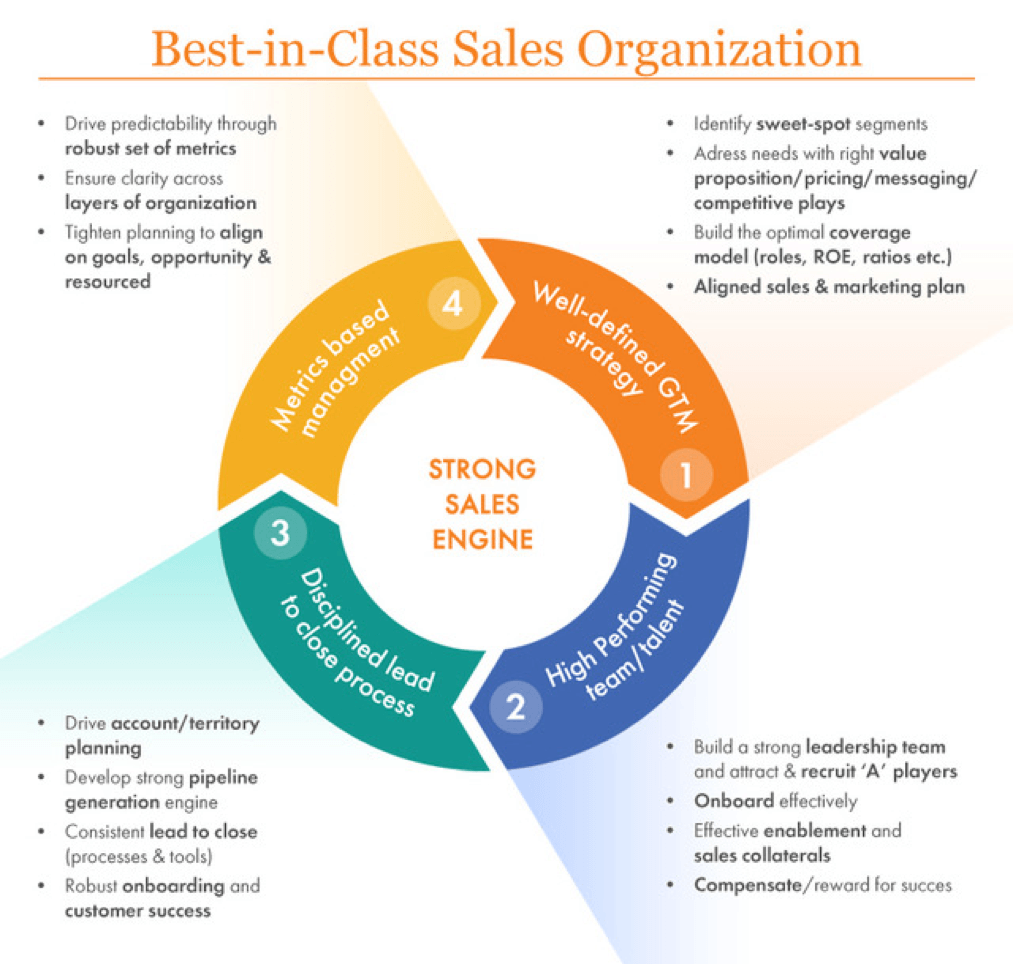Blueprint for Building a World Class Sales Engine

Companies live and die by their sales model: Providing the right product at the optimal price to the right customer at the right time, and repeating that process as quickly and efficiently as possible. At Insight Venture Partners we partner with our portfolio companies to build a repeatable sales engine by focusing on four key pillars – (1) crafting a well-defined go-to-market strategy, (2) building a high-performing sales team, (3) optimizing the lead-to-close process, and (4) using robust metrics to track progress. As you evaluate your company's sales model in 2017, use these pillars to evaluate whether you have the right foundations in place to achieve your sales targets.
Pillar #1: Craft a well-defined go-to-market strategy
The go-to-market (GTM) strategy is an action plan that defines how you'll most effectively compete for customers in your distinct market segments and drive alignment of the organization. Ask yourself:
- Do your sales teams know what your target market is?
- Is your current messaging resonating with the target market?
- Do you have the right sales roles and model to capture this market?
- Is your organization aligned towards a common goal?
An effective GTM strategy starts with a clear understanding of your ‘sweet spot’, how your product is differentiated with a clear message and value proposition, and where you have the best chance of capturing the Total Addressable Market (TAM). While there is temptation to serve all segments of the market, the most successful sales organizations narrow their focus in order to scale effectively.
Once your target segment(s) have been identified, it is critical to deploy the right resources to the right segments. Trade-offs & decisions on roles and capacity need to be made across a variety of dimensions:
- Inside (ISRs, SDRs etc.) vs. field sellers
- Hunters vs. farmers
- Territory reps vs. vertical market reps
- Sales vs. technical
- Direct vs. channel
Clear rules of engagement need to be defined to ensure these different resources are orchestrated to work effectively as a team in order to address the target segments.
Further, you should periodically assess your sales coverage model to determine if you have the right number of salespeople to effectively capture the opportunity in your product's chosen segments.
Finally, and importantly, sales and marketing should align around these target segments and the coverage model. Your marketing team should be focused on nurturing the sales lead pipeline, ensuring a steady flow of potential customers into the sales qualification process. Sales and marketing should be working together to take ownership of revenue, routinely sharing information to tune the GTM model.
Pillar #2: Build a high-performing team
Sales success requires top-tier talent. Like any other team, that starts with strong leadership capable of setting aggressive and achievable goals, and motivating their team to stretch themselves.
High performing sales organizations drive consistent performance across their sales teams rather than relying on a few top performers. To recruit more consistent talent, Insight encourages our portfolio companies to use pre-interview assessments to screen out low-quality candidates and also remove subjective indicators like a person's references or interview style. Working with Insight’s portfolio companies, Predictive Workplace Strategies has developed a fit-for-purpose assessment specifically tailored to three tech sales roles: Inside Sales reps, Consultative Sales reps and Sales Managers1.
Once hired, companies need to have a structured onboarding and certification process for new salespeople that covers, among other things, the company's go-to-market strategy, products, sales methodologies and market position so salespeople can ramp to full productivity effectively. Further codifying key customer wins, case studies, use-cases and plays ensures that the entire sales team is constantly learning from the success of the top performers while minimizing the long tail of underperformers.
Finally, compensate and reward high-performing salespeople for driving the strategic goals with a simple and easy to understand compensation model.
Pillar #3: Optimize lead-to-close process
All sales organizations must have a point of view on top of the funnel leads required to meet plan and the sources of these leads – i.e., how much is expected from marketing vs. ISR/SDR teams vs. field sales (depending on their business mix). Target customer lists for the field reps ensure that the salespeople are focusing their efforts on the right set of customers to build the pipeline.
With the right throughput of leads, sales organizations strive to do to two things:
- Consistently achieve plan
- Drive predictability and limit surprises
A well-defined sales process is critical to build a repeatable sales engine. A clear definition of the sales stages and the exit criteria (from one sales stage to another) drives pipeline integrity. Further these sales stages must closely mirror the customer journey to provide the right checklist for the sales teams to consistently drive an opportunity to close.
This also ensures that the sales teams are driving the right set of activities – like executive briefings, demos, POCs – all of which could be leading indicators for the team’s performance.
Finally, a consistent process enables the business leaders to make key investment decisions e.g., add resources given healthy pipeline, or add SDR teams to drive more leads.
Pillar #4: Use data to manage the sales model
You can only manage what you can measure. Most organizations struggle with how many metrics to measure, how frequently to measure them and who needs to see which metrics. A lack of consistent dashboards and cadence of inspecting the business results in frequent fire drills and adds more vibrations to the field.
How well can you answer these questions about your sales organization:
- How much time per day does the average salesperson spend selling, versus doing everything else?
- How quickly are you responding to inbound customer interest?
- What is your opportunity win rate? Which salespeople are able to close the highest ratio of sales opportunities and why? Which salespeople are struggling to close?
- How long does it take on average for the team to close a deal? Can that be compressed?
- How productive is your sales team?
- What percentage of revenue is coming from new customers versus existing customers?
The sales operations team has to work closely with the sales leadership to map out the various dashboards – weekly vs. monthly vs. quarterly, reps vs. sales managers vs. sales executives, performance vs. activities etc.
It's important to note that these metrics should be as automated as possible, and ideally be measured through your customer relationship management system (typically Salesforce.com). Every hour a sales leader spends manually collecting key performance indicators is an hour they're not spending with customers.
Having a clear view on these metrics enables the leadership to quickly zoom in on mitigation strategies in the event of a poor quarter rather than spending months trying to diagnose the issues. Further it aligns the rest of the organization around the goals.
The diagram below depicts how the Four Pillars work together to create a high performing sales team. Use this as a reference point as you continue to build out your sales engine in 2017.










